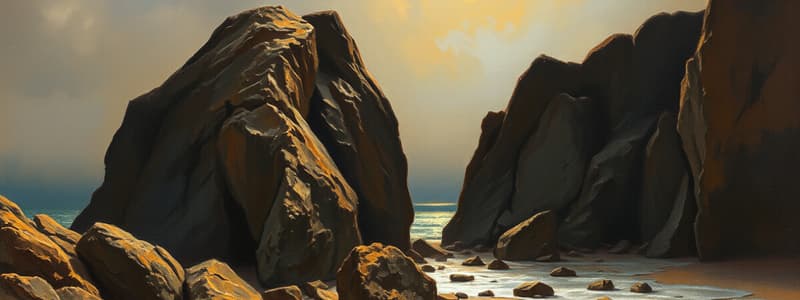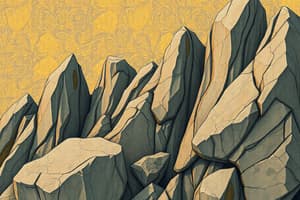Podcast
Questions and Answers
How can an igneous rock become a sedimentary rock, then a metamorphic rock, then igneous again?
How can an igneous rock become a sedimentary rock, then a metamorphic rock, then igneous again?
An igneous rock undergoes weathering and erosion to become a sedimentary rock, which can then be subjected to heat and pressure to become a metamorphic rock. Finally, the metamorphic rock can melt and cool to become an igneous rock again.
What is a rock?
What is a rock?
Any solid mass of material or mineral-like matter occurring naturally as part of our planet.
What are the three major types of rocks?
What are the three major types of rocks?
Igneous, sedimentary, and metamorphic.
How are the three types of rocks classified?
How are the three types of rocks classified?
Explain the rock cycle.
Explain the rock cycle.
What are the energy sources for the rock cycle?
What are the energy sources for the rock cycle?
What type of rock does each energy source form?
What type of rock does each energy source form?
What does the Law of Conservation of Matter tell us about the rock cycle?
What does the Law of Conservation of Matter tell us about the rock cycle?
What is igneous rock?
What is igneous rock?
What is magma?
What is magma?
What is lava?
What is lava?
What factor most influences crystal size in igneous rock?
What factor most influences crystal size in igneous rock?
What is texture in relation to rocks?
What is texture in relation to rocks?
What are the two types of igneous rocks?
What are the two types of igneous rocks?
How and where do the two types of igneous rocks form?
How and where do the two types of igneous rocks form?
What is sedimentary rock?
What is sedimentary rock?
List and explain the five steps in the formation of sedimentary rock.
List and explain the five steps in the formation of sedimentary rock.
What are the two types of sedimentary rock?
What are the two types of sedimentary rock?
What are the four major erosional agents?
What are the four major erosional agents?
In which rock type would fossils most likely be found?
In which rock type would fossils most likely be found?
What is metamorphic rock?
What is metamorphic rock?
What are the two types of metamorphic rock?
What are the two types of metamorphic rock?
What are the three agents of metamorphism?
What are the three agents of metamorphism?
What are the four agents of erosion?
What are the four agents of erosion?
What are the three agents of metamorphism?
What are the three agents of metamorphism?
Explain the difference between extrusive and intrusive igneous rocks.
Explain the difference between extrusive and intrusive igneous rocks.
Flashcards are hidden until you start studying
Study Notes
The Rock Cycle
- Igneous rocks transform into sedimentary rocks through weathering, erosion, deposition, compaction, and cementation.
- Sedimentary rocks can become metamorphic rocks when subjected to heat and pressure, often from tectonic processes.
- Metamorphic rocks can ultimately melt into magma, which, upon cooling, reform as igneous rocks.
Types of Rocks
- Three major types of rocks: igneous, sedimentary, and metamorphic.
- Classification of rocks is based on their formation process.
Energy Sources
- Earth’s internal heat is responsible for the formation of igneous and metamorphic rocks.
- Solar energy drives weathering processes and sediment movement leading to sedimentary rock formation.
Conservation of Matter
- The Law of Conservation of Matter indicates that the total amount of rock in the rock cycle remains constant.
Igneous Rocks
- Form from cooling magma (beneath the surface) or lava (on the surface).
- Cooling rate influences crystal size; slower cooling results in larger crystals.
- Two types: intrusive (formed inside the Earth) and extrusive (formed at the surface).
Sedimentary Rocks
- Created from compacted and cemented sediments.
- Formation process includes weathering, erosion, deposition, compaction, and cementation.
- Types: clastic (formed from fragments) and chemical (formed from mineral deposits).
- Fossils are predominantly found in sedimentary rocks.
Metamorphic Rocks
- Created under heat and pressure from existing igneous or sedimentary rocks.
- Types: foliated (layered appearance) and non-foliated (uniform texture).
- Three agents of metamorphism: heat, pressure, and hydrothermal solutions.
Erosion Factors
- Four major erosional agents: water, wind, ice, and gravity, which contribute to the breakdown and transport of rocks and sediments.
Studying That Suits You
Use AI to generate personalized quizzes and flashcards to suit your learning preferences.




